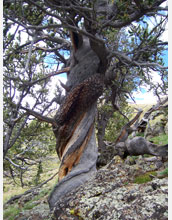Multimedia Gallery
Tree Rings Reveal Past Climate (Image 3)
A bristlecone pine tree growing near Summitville in the south San Juan Mountains, south of Tucson, Ariz. Bristlecone pines were used as a test subject by dendrochronologists working on a National Science Foundation (NSF)-supported paleoclimate study. (Date of Image: Summer 2008) [Image 3 of 3 related images. Back to Image 1.]
More About This Image
The study and dating of tree growth rings to understand past climate is called dendrochronology. Every year, a tree will add a growth ring around its trunk. Scientists use these rings to determine the tree's age (by counting backwards from the bark inward), as well as which years were good for growth and which were difficult. In years with more rainfall, a tree will grow a wide ring but in drier periods the ring is narrow. Scientists can average a pattern for a particular region and develop a chronology that shows which years were drier and which were wetter for that area.
In an NSF-supported study, Cody Routson, a doctoral candidate in the environmental studies lab at the University of Arizona's (UA) geosciences department, and associate professor Connie Woodhouse and professor Jonathan Overpeck, both from the geosciences department at UA, used tree rings to study indications of paleoclimate in the Southwestern U.S. and in particular, the history of North American summer monsoon. The team created a new tree ring record using their study findings in conjunction with existing regional records to evaluate periods of unusually severe drought over the past two millennia (B.C. 268 to A.D. 2009).
For test subjects the researchers primarily used bristlecone pines, the oldest and longest living species on Earth (some are over 4,000 years old). Bristlecones live on alpine and near-alpine mountain slopes, where they cling to bare, rocky landscapes, and are able to withstand severe drought.
To obtain samples from the trees without damaging them, the researchers used an increment borer, a tool that extracts a tree-ring core--a small, pencil-shaped sample of wood. Samples were taken from both living and dead trees. After samples were collected, they were taken back to the lab at UA, where the researchers used a visual graphic technique to match where the annual growth patterns of living trees overlapped with patterns in dead wood. Once a pattern was matched, the researchers measured the rings and averaged the values to generate a site chronology. The end result was a chronology for the south San Juan Mountains extending back 2,200 years--many years earlier than the medieval period, during which two major drought events in that region already were known from previous chronologies.
"The medieval period extends roughly from 800 to 1300 A.D.," says Routson. "During that period there was a lot of evidence from previous studies for increased aridity; in particular, two major droughts: One in the middle of the 12th century and one at the end of the 13th century. Very few records are long enough to assess the global conditions associated with these two periods of Southwestern aridity, and the available records have uncertainties."
But, the chronology from the San Juan bristlecone pines revealed some new information.
"There was another period of increased aridity even earlier," says Routson. "This new record shows that in addition to known droughts from the medieval period, there is also evidence for an earlier megadrought during the second century A.D. What we can see from our record is that it was a period of basically 50 consecutive years of below-average growth. And that's within a much broader period that extends from around 124 A.D. to 210 A.D.--about a 100-year-long period of dry conditions."
"We're showing that there are multiple extreme drought events that happened during our past in this region," said Routson. "These megadroughts lasted for decades, which is much longer than our current drought. And the climatic events behind these previous dry periods are really similar to what we're experiencing today." [Research supported by NSF grant AGS 08-23090.]
Credit: Cody Routson
Images and other media in the National Science Foundation Multimedia Gallery are available for use in print and electronic material by NSF employees, members of the media, university staff, teachers and the general public. All media in the gallery are intended for personal, educational and nonprofit/non-commercial use only.
Images credited to the National Science Foundation, a federal agency, are in the public domain. The images were created by employees of the United States Government as part of their official duties or prepared by contractors as "works for hire" for NSF. You may freely use NSF-credited images and, at your discretion, credit NSF with a "Courtesy: National Science Foundation" notation.
Additional information about general usage can be found in Conditions.
Also Available:
Download the high-resolution JPG version of the image. (4.6 MB)
Use your mouse to right-click (Mac users may need to Ctrl-click) the link above and choose the option that will save the file or target to your computer.

